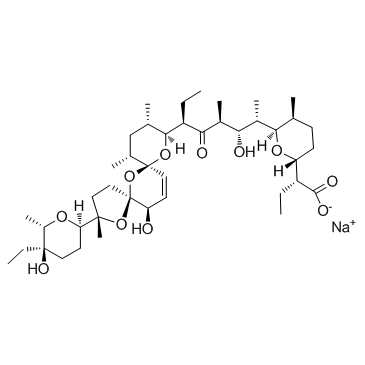
Salinomycin sodium
CAS No. 55721-31-8
Salinomycin sodium( Sodium salinomycin )
Catalog No. M15024 CAS No. 55721-31-8
A polyether ionophore antibacterial agent that shows effects on mitochondrial ion translocation and respiration.
Purity : >98% (HPLC)
 COA
COA
 Datasheet
Datasheet
 HNMR
HNMR
 HPLC
HPLC
 MSDS
MSDS
 Handing Instructions
Handing Instructions
| Size | Price / USD | Stock | Quantity |
| 100MG | Get Quote | In Stock |


|
| 200MG | Get Quote | In Stock |


|
| 500MG | Get Quote | In Stock |


|
| 1G | Get Quote | In Stock |


|
Biological Information
-
Product NameSalinomycin sodium
-
NoteResearch use only, not for human use.
-
Brief DescriptionA polyether ionophore antibacterial agent that shows effects on mitochondrial ion translocation and respiration.
-
DescriptionA polyether ionophore antibacterial agent that shows effects on mitochondrial ion translocation and respiration; inhibits Wnt signaling and selectively induces apoptosis in chronic lymphocytic leukemia cells; induces ER stress?mediated autophagy and apoptosis through generation of ROS in human glioma U87MG cells.(In Vitro):Salinomycin (0.1-8 μM) inhibits the growth of HUVECs in a dose-dependent manner, accounting for 32.1 and 59.2% inhibition at 4 and 8 μM, respectively. HUVECs exposed to 2, 4 and 8 μM of Salinomycin for 48 h show a dose-dependent reduction in cell number and a change in cell morphology. Salinomycin (4 μM) treatment effectively inhibits HUVEC migration and invasion, and significantly disrupt the capillary-like tube formation of HUVECs. Salinomycin significantly suppresses the expression levels of phosphorylated (p)-FAK in a time- and dose-dependent manner in HUVECs. Salinomycin inhibits HUVEC angiogenesis by disturbing the VEGF-VEGFR2-AKT signaling axis. Combination of RSVL and Salinomycin synergistically inhibits the proliferation of TNBC (MDA-MB-231) cells. RSVL and Salinomycin effectively reduce wound healing, colony and tumorosphere forming capability in TNBC cells. Synergistic combination of RSVL and Salinomycin induces apoptosis in both culture conditions by significant upregulation of Bax with decreased Bcl-2 expression as comparison to untreated and alone drug treatments. Salinomycin (0, 2, 4, 8 and 16 μM) significantly inhibits the proliferation of A2780 and SK-OV-3 cell lines in a dose- and time-dependent manner, (IC50 24h: 13.8 μM, IC50 48h: 6.888 μM and IC50 72h: 4.382 μM for A2780 cell lines), (IC50 24h: 12.7 μM, IC50 48h: 9.869 μM and IC50 72h: 5.022 μM for SK-OV-3 cell lines). Salinomycin blocks the Wnt/β-catenin pathway in EOC cells. Salinomycin (2 μM) reduces cancer cell proliferation, inhibits STAT3 phosphorylation and P38 and β-catenin expressions, and suppresses epithelial-mesenchymal transition in colorectal cancer cells. Salinomycin (1-5 μM) inhibits cancer cell proliferation and STAT3 signaling in colorectal cancer cells. Furthermore, Salinomycin activates Akt (Ser 473) and down-regulates Hsp27 (Ser 82) phosphorylation in HT-29 and SW480. Salinomycin down-regulates hTERT and reduces telomerase activity when combined with telomerase inhibitor.(In Vivo):Salinomycin (5 and 10 mg/kg) significantly supresses the average tumor volume and tumor weight. Salinomycin hinders the U251 human glioma cell growth in vivo via inhibition of angiogenesis with involvement of AKT and FAK dephosphorylation. Salinomycin (0.5 mg/kg b.wt.) enhances the mean survival time of the tumor bearing Swiss albino mice.
-
In Vitro——
-
In Vivo——
-
SynonymsSodium salinomycin
-
PathwayGPCR/G Protein
-
TargetAntibacterial
-
RecptorAntibacterial
-
Research AreaInfection
-
Indication——
Chemical Information
-
CAS Number55721-31-8
-
Formula Weight772.9804
-
Molecular FormulaC42H69NaO11
-
Purity>98% (HPLC)
-
SolubilityDMSO: ≥ 15 mg/mL
-
SMILESCCC(C1CCC(C(O1)C(C)C(C(C)C(=O)C(CC)C2C(CC(C3(O2)C=CC(C4(O3)CCC(O4)(C)C5CCC(C(O5)C)(CC)O)O)C)C)O)C)C(=O)[O-].[Na+]
-
Chemical NameSalinomycin, sodium salt (1:1)
Shipping & Storage Information
-
Storage(-20℃)
-
ShippingWith Ice Pack
-
Stability≥ 2 years
Reference
1. Mitani M, et al. Antimicrob Agents Chemother. 1976 Apr;9(4):655-60.
2. Lu D, et al. Proc Natl Acad Sci U S A. 2011 Aug 9;108(32):13253-7.
3. Yu SN, et al. Oncol Rep. 2017 Jun;37(6):3321-3328.
molnova catalog



related products
-
PA3552-IN-1
PA3552-IN-1 is an antibiotic adjuvant that can reduce the expression of PA3552 and restore the sensitivity of MDR Pseudomonas aeruginosa DK2 strain to Polymyxin B.
-
Solithromycin
A novel fluoroketolide with lower MICs than those of telithromycin and macrolides.
-
A7132
A7132 is an antibacterial agent and possesses broad and potent antibacterial activity.



 Cart
Cart
 sales@molnova.com
sales@molnova.com


